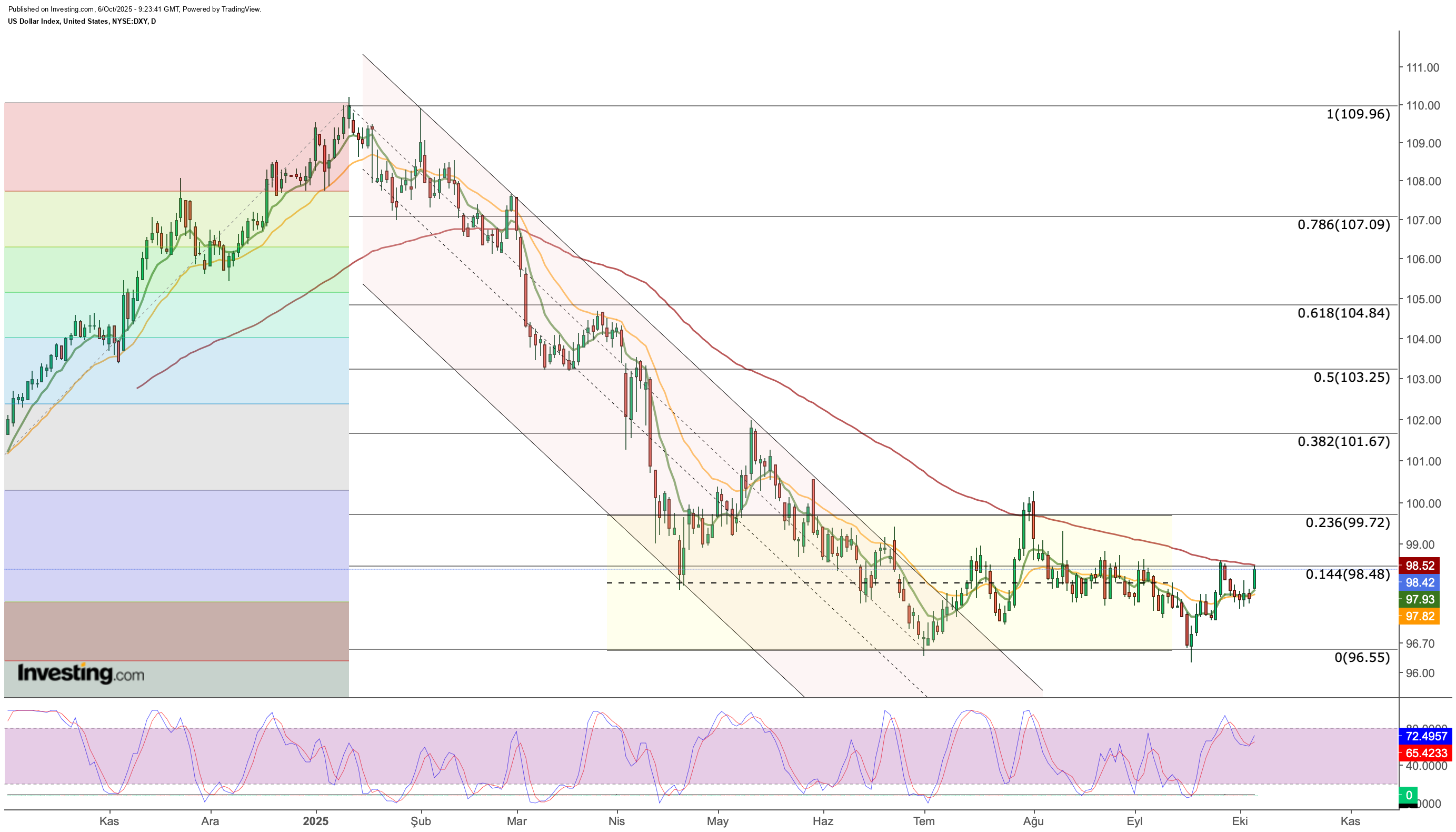
-
The US dollar gained strength as the yen fell sharply on Japan’s political changes.
-
Fed uncertainty and the government shutdown increased market caution, boosting the US dollar temporarily.
-
Rising oil prices and short-term technical momentum supported the US dollar, but long-term risks remain.
- Looking for actionable trade ideas to navigate the current market volatility? Subscribe here to unlock access to InvestingPro’s AI-selected stock winners.
The US dollar started the week strong, recovering the losses from last week. The US dollar index reached 98.48, its highest in 10 days, mainly because it rose sharply against the . This movement reflects political changes in Japan and economic uncertainties in the US.
The main reason for the US dollar’s rise was the yen’s sharp fall. Sanae Takaichi won the leadership of Japan’s ruling party and is set to become the new prime minister. Takaichi supports bigger government spending and loose monetary policies, which markets see as a return to the “Abenomics 2.0” approach.
Because of her policies, the yen came under pressure. The USD/JPY exchange rate jumped nearly 2% to 150.43, a two-month high, helping the US dollar strengthen globally.
Takaichi’s support for fiscal stimulus weakens the yen, and any by Japan’s central bank is likely delayed until 2026. This keeps the US dollar more attractive since the difference in interest rates between the US and Japan will stay high.
Fed Uncertainty and the US Shutdown Effect
Another reason the US dollar index is strong comes from political and economic issues in the US. The federal government shutdown is delaying important economic reports, especially the September employment data. This makes it harder for the to make decisions based on data and adds uncertainty for markets.
Even so, recent economic numbers have raised expectations for a small 0.25% Fed rate cut this month. CME FedWatch data shows a roughly 95% chance of this cut in October. Markets are also starting to expect a second cut in December.
This week, comments from Fed officials, including the and Fed Chair Jerome Powell’s speech on Wednesday, could strongly influence the US dollar index. Markets will watch closely for any sign that the Fed might take a more “hawkish” stance.
Oil Prices and Safe Harbor Dynamics
The US dollar also got support from the energy market. OPEC+ decided to increase oil production in November, which pushed oil prices higher. Higher oil prices increased demand for the US dollar because the US plays a key role in global energy production and trade. So, rising oil prices indirectly help the US dollar.
At the same time, the US dollar has fallen about 10% since the start of the year, showing that investors are now looking at other safe-haven options. Overall, the Fed’s move toward easier monetary policy and possible signs of slower economic growth make the US dollar more vulnerable over the long term.
US Dollar’s Technical Outlook

Last week, the US dollar index held its support at 97.50, and moving above 98 at the start of this week gave it short-term strength.
The US dollar is now testing the 98.50 level, which has been a strong resistance in the past. This level also matches the middle of the recent trading range and the 3-month moving average, making it important. If the US dollar breaks above it, the next target could be 99.70. Strong momentum could slow risky markets and push investors toward the US dollar as a safe-haven.
If the government shutdown ends quickly, the impact on the US dollar may be neutral or even positive. But if uncertainty continues, the US dollar could weaken again. In that case, the Fed’s guidance on interest rates and policy changes in Japan will be key in determining the direction of the US dollar.
Technically, the US dollar staying below 98.50 may indicate that the pressure has come to the fore again. In this case, 97.50 can be tested again as intermediate support. In case of a breakout, the probability of the downward trend continuing towards the main support at 96.50 will increase.
As a result, although the US dollar index continues its upward trend in the short term, the room for maneuver may remain limited due to political and monetary uncertainties in the US. The 97 region stands out as strong support, while the 99.70 level stands out as critical resistance.
If the US dollar stays below 98.50, it may face renewed pressure. In that case, 97.50 could act as an intermediate support. If it breaks below this level, the US dollar could continue falling toward the main support at 96.50.
Overall, the US dollar index is rising in the short term, but political and monetary uncertainties in the US may limit its gains. The 97 level is strong support, while 99.70 is a key resistance level.
****
InvestingPro provides a comprehensive suite of tools designed to help investors make informed decisions in any market environment. These include:
- AI-managed stock market strategies re-evaluated monthly.
- 10 years of historical financial data for thousands of global stocks.
- A database of investor, billionaire, and hedge fund positions.
- And many other tools that help tens of thousands of investors outperform the market every day!
Not a Pro member yet? Check out our plans here.
Disclaimer: This article is written for informational purposes only. It is not intended to encourage the purchase of assets in any way, nor does it constitute a solicitation, offer, recommendation or suggestion to invest. I would like to remind you that all assets are evaluated from multiple perspectives and are highly risky, so any investment decision and the associated risk belongs to the investor. We also do not provide any investment advisory services.
